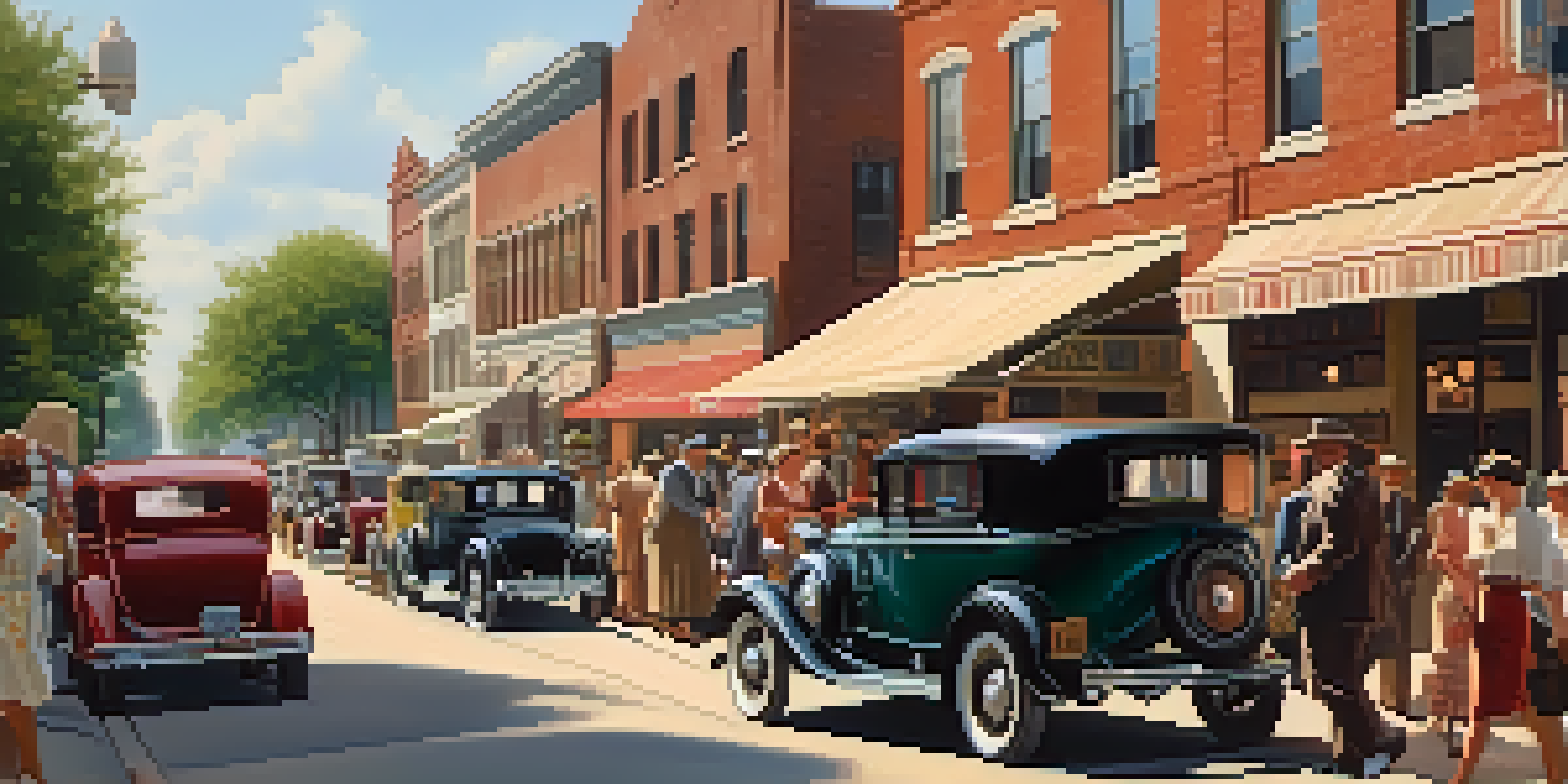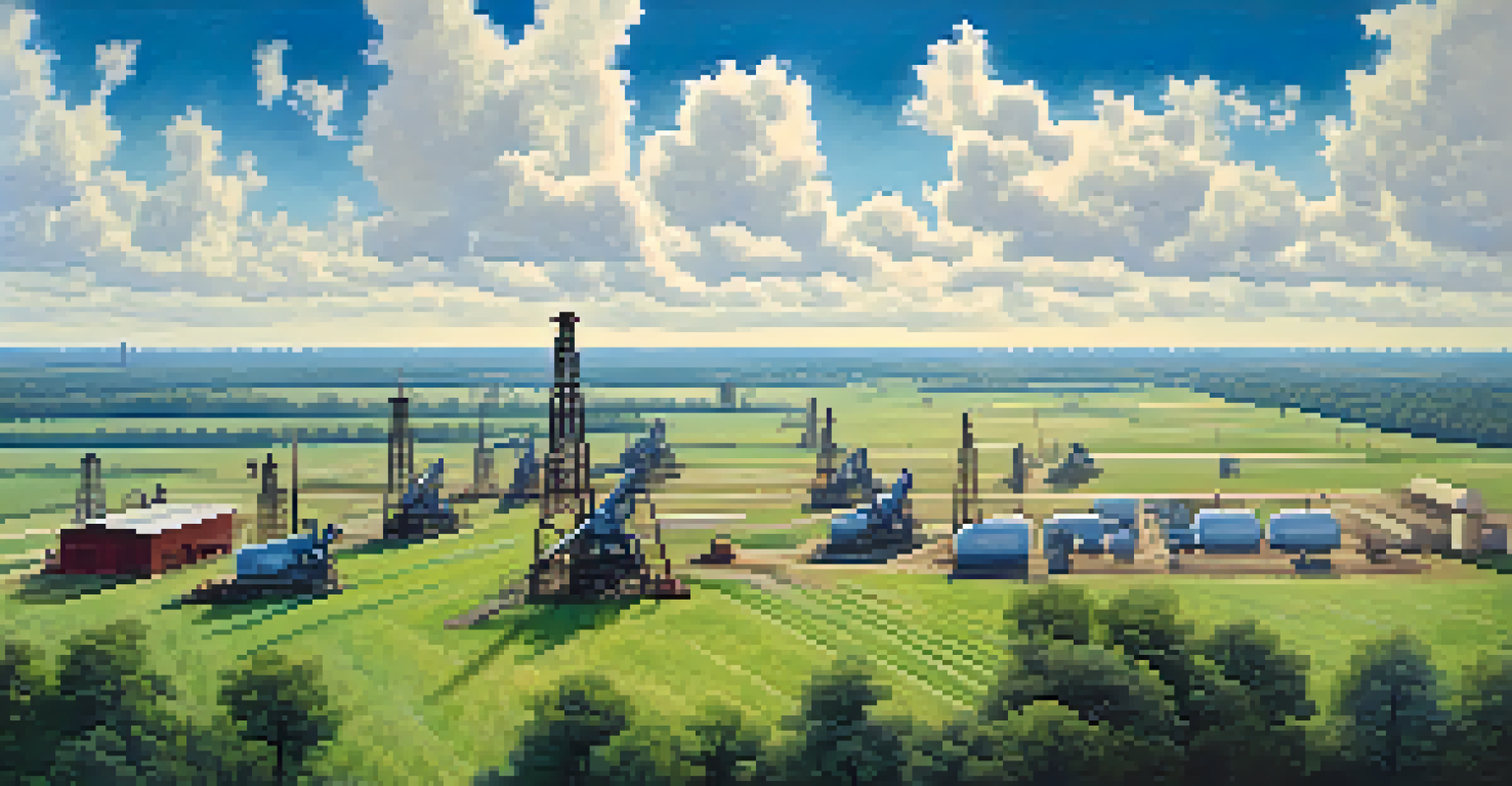The Discovery of Oil: Transforming Dallas in the 1930s

The Pre-Oil Era: Dallas Before the Boom
Before the 1930s, Dallas was known primarily as a trading and transportation hub. With its strategic location and railroads, the city served as a crucial link between agricultural regions and markets. However, the economy was largely reliant on agriculture and trade, making it vulnerable to fluctuations in those sectors. The arrival of oil would soon change everything, setting the stage for a new era of prosperity.
The best way to predict the future is to create it.
Life in Dallas revolved around its close-knit communities and local businesses. The lack of industrial growth limited job opportunities, and many residents had to look elsewhere for better prospects. There was a palpable sense of stagnation, as the city struggled to find its identity amidst the economic challenges of the Great Depression. People were eager for change, and little did they know that a black gold rush was on the horizon.
The 1930s were marked by uncertainty, but the discovery of oil would soon ignite hope and ambition in the hearts of Dallas residents. As whispers of oil reserves began to circulate, the community's spirit and dreams for a brighter future started to take shape. The stage was set for a transformation that would redefine Dallas forever.
The Discovery of Oil: A Game Changer
In 1930, the discovery of oil at the nearby East Texas Oil Field sent shockwaves throughout the region. Dallas became the epicenter of this burgeoning industry, attracting investors, entrepreneurs, and workers from all walks of life. The allure of wealth and opportunity drew people to Dallas, forever altering its demographic and economic landscape. The once quiet city was now buzzing with excitement and possibility.

The oil boom brought with it a wave of optimism and ambition, as people flocked to the city to stake their claims in this new gold rush. The population began to swell, with many seeking jobs in the oil fields or starting businesses that catered to the growing industry. From drilling companies to service stations, the oil economy created a ripple effect that would touch nearly every aspect of life in Dallas.
Dallas Transformed by Oil Discovery
The discovery of oil in the 1930s shifted Dallas from a trading hub to an economic powerhouse, attracting a diverse population and igniting growth.
This sudden influx of wealth transformed the city in ways that were previously unimaginable. New businesses flourished, infrastructure improved, and Dallas began to position itself as a key player in the oil industry. The once modest city was evolving into a bustling metropolis, as its residents embraced the opportunities that came with this newfound prosperity.
Economic Growth: The Oil Boom's Impact
The economic impact of the oil boom was profound, as Dallas experienced rapid growth and development in the 1930s. Oil revenues fueled investments in infrastructure, leading to improved roads, schools, and public services. As the city expanded, so did the job market, providing much-needed employment opportunities for locals and newcomers alike. The oil industry became the lifeblood of the city's economy, providing stability during uncertain times.
Change is the law of life. And those who look only to the past or present are certain to miss the future.
As oil production ramped up, Dallas emerged as a hub for oil companies and related businesses. This newfound economic clout not only strengthened the city's finances but also attracted national attention. Dallas began to host oil conferences and trade shows, positioning itself as a key player in the oil industry. The city's reputation as an oil capital continued to grow, drawing even more investment and talent.
The influx of capital also allowed for artistic and cultural developments, as new theaters, museums, and community centers sprang up across the city. The oil boom not only transformed Dallas's economy but also enriched its cultural landscape. With prosperity came creativity, shaping a vibrant city that embraced innovation and originality.
Social Changes: A Diverse Community Emerges
The oil boom attracted a diverse group of people to Dallas, each bringing their unique skills and backgrounds. As the workforce expanded, so did the city's cultural fabric, with new residents contributing to the rich tapestry of life in Dallas. This diversity fostered a sense of community, where different cultures and traditions coexisted and thrived. The city began to embrace its multicultural identity, reflecting the many influences that shaped its growth.
With the influx of workers came new ideas and perspectives, sparking social change and progress. The necessity of collaboration in the oil industry encouraged teamwork and camaraderie among its diverse workforce. This spirit of unity laid the groundwork for a more inclusive community, as residents began to advocate for equal opportunities and rights.
Economic Boom Fuels Infrastructure Growth
The oil boom led to significant investments in infrastructure, enhancing transportation and public services that supported the burgeoning economy.
As Dallas grew, so did its sense of pride and ambition. The collective dream of prosperity united the residents, who worked together to build a better future for themselves and their families. The social transformation that accompanied the oil boom forged a new identity for Dallas, one that celebrated diversity and collaboration.
Infrastructure Development: Building a Modern City
The surge in oil-related activity necessitated significant infrastructure development in Dallas. New roads, bridges, and transportation systems were constructed to accommodate the increased movement of goods and people. This newfound connectivity not only supported the oil industry but also facilitated trade and commerce in other sectors, enhancing the overall economic landscape of the city.
As the city expanded, the demand for housing and commercial space grew. Developers rushed to build residential neighborhoods, office buildings, and retail establishments to cater to the booming population. This rapid urbanization transformed the cityscape of Dallas, turning it into a bustling metropolis with modern amenities and services that attracted even more residents and businesses.
The commitment to infrastructure development laid the foundation for Dallas’s future growth and success. As the city evolved, its investment in transportation and public services positioned it as a regional leader. These improvements not only supported the oil industry but also enhanced the quality of life for all residents, creating a vibrant urban environment.
Cultural Flourishing: The Arts and Community Spirit
The economic prosperity brought about by the oil boom also led to a flourishing of the arts and cultural scene in Dallas. With increased revenues, residents began to invest in theaters, galleries, and music venues. The city welcomed artists, musicians, and performers, creating a vibrant cultural landscape that enriched the community's spirit. The arts became a vital part of Dallas's identity, fostering creativity and innovation.
Community events and festivals started to become a staple of life in Dallas, celebrating the diverse cultures and traditions that had taken root. These gatherings not only showcased local talent but also fostered a sense of belonging and pride among residents. The collaborative spirit that emerged from the oil boom extended into cultural endeavors, bringing people together to celebrate their shared experiences and aspirations.
Cultural Renaissance After Oil Boom
With increased wealth from the oil industry, Dallas experienced a flourishing arts scene and stronger community ties, shaping the city's identity.
As Dallas continued to grow and evolve, the arts became a powerful tool for social change and community building. The creativity and talent that flourished during this period left a lasting legacy in the city, shaping its identity for generations to come. The cultural renaissance that accompanied the oil boom transformed Dallas into a place where creativity thrived and community bonds strengthened.
Lasting Legacy: Oil's Impact on Dallas Today
The discovery of oil in the 1930s set into motion a series of changes that would leave a lasting legacy on Dallas. The city transformed from a modest trading post into a bustling metropolis, driven by the oil industry and the opportunities it created. This economic boom laid the groundwork for Dallas's future success, establishing it as a key player in various industries beyond oil, including technology, finance, and healthcare.
The cultural and social changes that emerged during this period also continue to influence Dallas today. The city's rich tapestry of diverse communities and artistic expression is a testament to the collaborative spirit that took root during the oil boom. As Dallas continues to grow and evolve, it remains a vibrant and inclusive city that celebrates its unique history and heritage.

While the oil industry may have driven the initial transformation, the lessons learned during this period have paved the way for a more resilient and adaptable Dallas. The legacy of the oil boom is not only evident in the city's economic success but also in its commitment to innovation, diversity, and community. As Dallas looks to the future, it carries with it the spirit of ambition and unity that defined its journey in the 1930s.